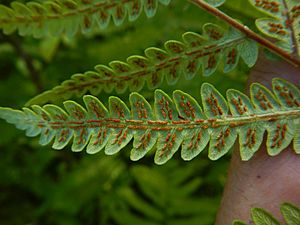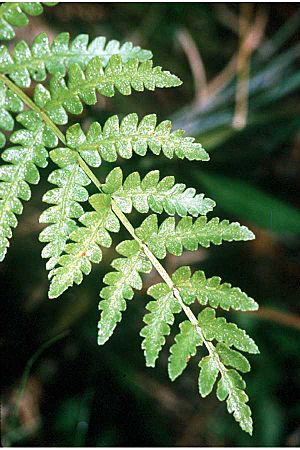Virginia chain fern facts for kids
Quick facts for kids Virginia chain fern |
|
|---|---|
 |
|
| Spore cases (sori) | |
| Conservation status | |
| Scientific classification | |
| Genus: |
Anchistea
|
| Species: |
virginica
|
| Synonyms | |
|
|
The Virginia chain fern (scientific name: Anchistea virginica) is a type of fern. It's the only species in its group, called Anchistea. You might also hear it called Woodwardia virginica.
This fern has long, creeping stems that grow underground. These stems are called rhizomes. They are scaly and help the fern spread out. From these rhizomes, tall leaves grow, reaching up to about 4 feet (120 centimeters). These leaves are separate from each other and fall off in the autumn.
Some other ferns, like the Cinnamon fern, look a bit similar. But the Virginia chain fern's leaves grow one by one, not in a big bunch. Also, all its leaves look the same, unlike some ferns that have special leaves just for making spores.
The lower part of the leaf stem is dark purple to black and shiny. The upper part is dull green. The leaf itself is green and shaped like a spear. It has 12 to 23 pairs of smaller leaf parts, called pinnae, that grow on opposite sides of the stem. Each of these pinnae is divided into even smaller segments.
The fern's spore-producing bodies, called sori, are found on the underside of the pinnae. They are long and form two rows that follow the main veins of the leaf. Like all ferns, the Virginia chain fern has a special life cycle with different stages. It produces tiny, independent plants called prothalli from its spores. The spores are found in reddish-brown sori.
Contents
About the Virginia Chain Fern
This section tells you more about the Virginia chain fern. You will learn about its scientific name and how it was discovered.
Naming the Virginia Chain Fern
The Virginia chain fern was first described in 1771 by a famous scientist named Carl Linnaeus. He called it Blechnum virginicum. Later, in 1793, James Edward Smith moved it to a different group called Woodwardia. Then, in 1851, Carl Borivoj Presl placed it in the group Anchistea.
Some scientists still use the name Woodwardia for this fern. However, a big group of fern experts, called the Pteridophyte Phylogeny Group (PPG I), decided in 2016 to keep Presl's name, Anchistea. This means the Virginia chain fern is the only species in the Anchistea group.
Ancient Ferns: Fossils of Anchistea virginica
Scientists have found fossils of Anchistea virginica! These fossils were discovered in Central Washington state and are from the Middle Miocene period. This shows that the Virginia chain fern has been around for a very long time. It seems that even back then, it grew in similar places and with similar plants as it does today.
Where the Virginia Chain Fern Lives
This fern is found only in eastern North America. It grows from Florida all the way up to Nova Scotia in Canada. It also spreads west to Michigan and Illinois.
Most of these ferns live in the Atlantic coastal plain and the Piedmont regions. However, you can also find them in the eastern Great Lakes area, reaching as far west as Illinois. You can often find maps online that show exactly where this fern grows.
Fern Homes: Ecology and Conservation
The Virginia chain fern likes to grow in wet places. You can find it in open, wet, swampy woods, in acidic bogs, and along streams. It also grows in ditches beside roads. This fern does not like soils that have a lot of lime (calcareous substrates).
This fern is an important part of the plant life in certain types of forests. It grows in flatwoods, in swamps with Atlantic white cedar trees, and in forests with bay trees.
Growing and Using the Virginia Chain Fern
Sometimes, people grow the Virginia chain fern in greenhouses or as a decorative plant in their gardens. It is a tough plant that can survive cold winters. It can grow in areas where temperatures drop to USDA Zone 3.



